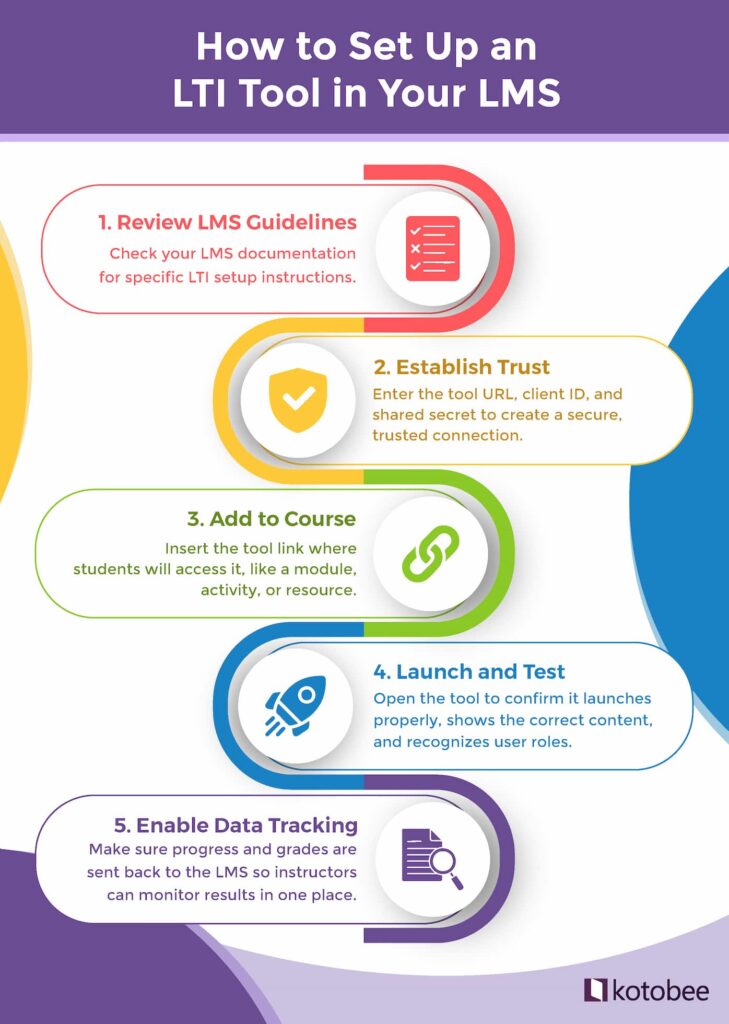Online learning today relies on a wide range of tools and apps, but switching between platforms and managing multiple logins can slow down both the teaching and learning processes. This leaves users (including students and educators) often spending more time navigating systems than actually learning.
LTI changes that. It allows you to connect your favorite learning tools directly to your learning management system (LMS), making everything feel like one seamless platform. From interactive quizzes to ebooks and other learning apps, LTI helps your students focus on learning while keeping everything organized and easy to manage.
If you’re wondering: what is LTI exactly? And how does it work? Then just keep reading; this article will provide you with everything you need to know about this powerful standard for connecting learning tools to your LMS.
What Is LTI?
Learning Tools Interoperability (LTI) is a standard that makes it easy to connect different learning tools and courseware with your LMS. In other words, it lets you launch tools and resources (like quizzes, learning apps, or even ebooks) directly inside your LMS, without needing separate logins or complicated setups.
Without LTI, students might need to leave their LMS, log into a separate site, and access an ebook with no progress tracking. With LTI, that same ebook opens directly inside the LMS, updates automatically, and even reports progress back to the instructor. This makes the whole process easier for both the educator and the learners.
LTI was developed by 1EdTech (formerly IMS Global Learning Consortium). Their goal was to create a universal standard that allows educational tools from different providers to communicate securely and share data, such as grades or learner progress, in real time.
What Is LTI Integration?
An LTI integration is what connects your LMS to other learning tools so they can work together safely. It’s the setup process that lets tools like quizzes, video apps, or ebooks open directly inside the LMS without extra logins or complicated steps. For example, instead of asking students to visit an external site to take a quiz, an LTI integration allows them to complete it right inside the LMS, and then their scores can appear automatically in the gradebook.

How Does LTI Work? (And How to Implement It?)
LTI works by creating a safe link between the LMS and the external tool, allowing them to share user details securely, without requiring any extra logins. When someone accesses the tool from the LMS, the system sends a secure request that includes user and course information, and the tool then opens right inside the LMS. It also allows important data (such as students’ progress or grades) to flow back into the LMS gradebook and activity tracking.
Here is how it typically works:
- Establishing trust: The LMS administrator sets up the connection using details provided by the tool’s vendor, like a tool URL, client ID, and shared secret. This step makes sure both systems recognize and trust each other.
- Adding the tool: Once connected, the administrator or instructor adds the tool as a resource inside a course (for example, a quiz, ebook, or video app).
- Launching the tool: When students click the link, the LMS securely passes their information (like name, role, and course details) to the tool. The tool then uses this data to display the right content for that student.
- Providing seamless access: The tool then opens inside the LMS interface itself through an iframe or embedded view, which gives the impression of a single system. This way, learners don’t have to switch platforms or re-enter credentials.
- Returning results: As the students interact with the tool, data such as completion status or scores can be sent back to the LMS, providing instructors with a complete view of their performance from one central place.
After everything is set up, it’s a good idea to test the connection before giving instructors or students access. Make sure the tool opens properly and that data (like grades and progress) flows back to the LMS as expected. And since setup steps can differ slightly across LMSs, always check your platform’s documentation to ensure the setup is completed properly.

Why Is LTI Important?
LTI plays a vital role in making online learning more connected, consistent, and efficient. Instead of forcing students and instructors to juggle multiple platforms, logins, and interfaces, LTI brings everything together inside one familiar space: your LMS.
This means learners can stay focused on learning, while educators spend less time managing tools and more time teaching. It also gives institutions a reliable, secure way to adopt new educational technologies, without any complex setup or system changes.
Here are some of the main reasons LTI matters in modern elearning:
- Single Sign-On (SSO): With LTI, users only need their LMS login credentials to access external tools; no extra accounts or passwords needed.
- Smooth user experience: Tools open inside the LMS (often within an iframe), making them feel like part of the course environment.
- Relevant content delivery: LTI passes course and user details (such as role, course ID, or group) to the educational tool, which then delivers the right material in the right context.
- Stronger security: The newest version of LTI offers better protection to keep student data safe.
- Flexibility and choice: Because LTI is a widely adopted standard, institutions can easily plug in a variety of third-party tools without being locked into a single vendor.
- Cost and time efficiency: Since LTI is an open standard supported by most LMSs, institutions can easily plug in new tools without expensive custom integrations. This reduces setup costs, saves time, and makes it easier to adopt new learning technologies quickly.

Which LTI Version Should You Use?
Over the years, LTI has evolved through several versions, each improving security and functionality. Earlier versions (like LTI 1.1 and 1.2) handled basic integrations, while LTI 2.0 introduced complex features that were never widely adopted.
Today, most modern LMSs and learning tools use LTI 1.3 along with LTI Advantage, which adds enhanced security, automatic grade return, roster sharing, and deep linking. If you’re setting up a new integration, this is the version you’ll want to look for.
LTI vs Other Standards (SCORM & xAPI)
When discussing the different elearning standards available, you might hear LTI mentioned alongside SCORM and xAPI. While they all aim to improve digital learning, they are not the same. Each standard addresses a different need: SCORM focuses on delivering packaged courses, xAPI on tracking a wide range of learning activities, and LTI on integrating external tools into the LMS. To be more precise, LTI is about integration and tool interoperability, while SCORM and xAPI track learner activity and progress. They serve different (but complementary) purposes.
Here’s an overview of each of them:
- SCORM (Sharable Content Object Reference Model): SCORM is mainly about packaging content (such as courses) so it can run in an LMS. It tracks basic information, like whether a learner has completed a course or how long they spent on it.
- xAPI (Experience API, or TinCan): xAPI goes further by capturing learning experiences inside and outside the LMS. For example, it can record when a learner watches a video, attends a workshop, or reads an article. These records are stored in a Learning Record Store (LRS).
- LTI (Learning Tools Interoperability): Unlike SCORM or xAPI, LTI focuses on connecting external tools and applications directly into the LMS. It handles things like logins, passing course details, and returning grades, making external resources feel like part of the LMS.
| SCORM | xAPI | LTI | |
| Main Purpose | Packages and delivers courses in an LMS | Tracks diverse learning experiences (in and out of LMS) | Connects external tools and apps directly into an LMS |
| Data Tracked | Completion, time spent, quiz scores | Any type of activity (videos, workshops, articles, etc.) | User info, course context, grades, progress |
| Where It Works | Inside the LMS | Inside and outside the LMS (via LRS) | Inside the LMS, linking to external tools |
| Ease of Integration | Limited to SCORM-compliant LMSs | Requires LRS setup | Widely supported by LMSs, plug-and-play for many tools |
Challenges and Limitations of LTI
Although LTI is designed to simplify the connection between LMSs and external tools, it can come with its own set of challenges. They usually appear during setup and maintenance, or when institutions try to take advantage of newer features. Understanding these issues early can help avoid any disruptions.
Here are some common challenges and ways to address them:
- Version compatibility: Not all LMSs and tools support the latest version of LTI (such as LTI 1.3). So make sure to choose educational tools that are committed to supporting the newest LTI standards and confirm compatibility with your LMS before adoption or purchasing.
- Initial setup: Setting up the connection between an LMS and an external tool can be technical and may need help from an administrator. Working with IT staff and following the vendor’s instructions can make the process much easier.
- Ongoing maintenance: As LMSs, tools, and standards evolve, integrations may need updates to remain functional and secure. That’s why it’s important to schedule regular checks and updates to ensure everything runs smoothly and securely.
- Training and awareness: Instructors and staff may need guidance on how to make the most of LTI-enabled tools. To address this, try offering short training sessions or resource guides to help them use LT integration effectively.
Examples of LTI Tools
Many learning tools use LTI to connect directly with LMSs, removing extra logins and setup hassles. Such integration allows these tools to share student progress, grades, and activity data. To see how this works in practice, here are a few examples of tools you can integrate into your LMS using LTI:
- Kotobee: Using LTI, interactive ebooks created with Kotobee can open right inside the LMS, so students can read and learn without switching between platforms. This makes learning easier and more connected, while instructors can easily track progress, completion rates, and quiz results.
Important read: Ebook and LMS Integration Using LTI
- Turnitin: This tool offers plagiarism detection and assignment evaluation within the LMS. It gives educators detailed insights into student submissions, without requiring separate logins or platforms.
- Zoom: Live online sessions scheduled through Zoom can integrate with your LMS. This way, attendance and participation records are automatically captured, which can help teachers manage virtual classes more efficiently.
- Kaltura: Video lessons, interactive video quizzes, and analytics are all accessible within the LMS when using Kaltura and LTI.
- VoiceThread: This tool allows students to create online presentations by including images, documents, videos, and other media, where others can leave comments and participate in discussions.
Wrapping Up
LTI takes learning beyond the limits of a traditional LMS, bringing all your favorite tools together in one space. No more juggling tabs or remembering countless passwords; just a smooth, connected learning experience that keeps everyone focused on what matters most.
And with tools like Kotobee, you can turn that connection into something truly interactive. So start using LTI to bring ebooks, quizzes, and multimedia right into your LMS, and watch how effortless and enjoyable learning can become.
.
Read More
Top Educational Technology Tools for Students in 2026


